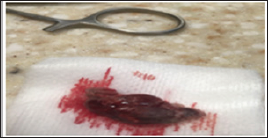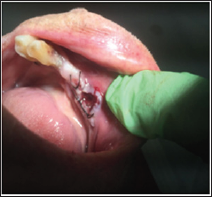Impact Factor : 0.548
- NLM ID: 101723284
- OCoLC: 999826537
- LCCN: 2017202541
Natalia Elson*1 and Irene Brandes2
Received: April 03, 2018; Published: April 18, 2018
*Corresponding author: Natalia Elson, Clinical Assistant Professor, NYU Dentistry, New York, NY, USA
DOI: 10.26717/BJSTR.2018.03.000973
The purpose of this article is to discuss the management of postoperative complications such as bleeding and the "liver clot” formation. The diagnosis of "lover clot” is based on the clinical appearance, due to the similarity to the tissue of the liver. Minor bleeding post extraction is a common occurrence in oral surgery. This event might occur during the procedure, immediate after the extraction or about 1-3 days postsurgery. However, significant bleeding is an unusual, if not rare event encountered post treatment, in dental practice, even for patients without any known risk factors. A review of the medical and dental literature revealed only ten reports of excessive bleeding, drug-abuse related following dental procedures [1]. To achieve a proper homeostasis, a certain protocol should be followed. Detailed review of patient's medical history is imperative in preventing any post extraction complications. In some cases consultation with patient's physician is necessary. Certain conditions such as liver disease, cancer, congestive heart failure, ant platelet agents, anticoagulants and pain management medications, as well as advanced age can contribute to excessive post extraction bleeding.
In some extreme cases (lower than 20000 platelets per micro liter), platelets transfusion is indicated. On the other hand, several observational studies demonstrated the safety in performing invasive procedures for patients with thrombocytopenia whom did not receive any prophylactic PLT transfusions [2] .These findings support the notion that in patients with INR <3.0, it is relatively safe to perform tooth extraction without a significant increase in the risk of bleeding [3]. However if a patient with blood clotting problems presents for an emergency visit, the decision to provide treatment might be based on dentist's level of comfort in performing the surgical procedure. The utilization of certain local measures: local infiltration anesthesia in addition to inferior alveolar nerve block, placement of Gelfoam, careful suturing, Ice pack utilization, etc., will contribute to a successful outcome.
Keywords: Hemostasis; Platelets Disorder;” Liver Clot”; Laser; LLLT
"I broke my tooth today and I have excruciating pain”. Medical history was reviewed with the patient and consisted of: history of prostate cancer, hyperthyroidism, congenital heart disorder, kidney malfunction. He is on a multi medication regimen: Aspirin, Warfarin, and Synthroid. Upon intraoral evaluation tooth # 27 has pain on percussion and palpation, class II mobility, % of clinical crown missing. Diagnosis: Tooth #27 fractured caronally, advanced localized periodontal disease, tooth non-restorable. Patient is edentulous on maxilla and only teeth #21, #22, #27 and root tip of #20 are present on the mandible. Patient is wearing complete upper and partial lower dentures. Phone conversation with patient's physician in order to discuss medical history. Due to the urgency of the situation, patient's medications could not be stopped. In addition to the risk of morbidity and mortality from thromboembolic events, the literature suggests that lowering the INR level is expensive and unnecessary from the standpoint of the likelihood of bleeding from dental procedures [1]. Patient's latest INR was 3, platelet count 50.000. Discussed treatment options with patient and written informed consent was obtained. Vital signs taken: Pulse 75/min. BP 156/87 mmHg.
Topical anesthetic HurriCaine (20% Benzocaine), Beutlich Pharmaceuticals, LLC, IL, USA placed for 30 sec followed by 4% Septocaine (Septodont) local infiltration 1.7 ml-1 carpules, tooth #27 was extracted atraumatic with ridge preservation, extraction site was evaluated and rinsed with saline (0.9% Sodium Chloride). Postoperative measures to control bleeding were initially applying finger pressure with sterile gauze for 10 minutes, then applying with new sterile gauze. At the same time Ice pack was applied. To prevent possible bleeding Gelfoam (absorbable gelatin sponge, USP, Pfizer), and non-resorbable sutures (UNISILK 4/0, round body non-capillary braided silk black) were used for wound closure. Patient was given detailed, written postoperative and verbal instructions. Patient was kept in the office for one hour in order to monitor the bleeding. Follow up visit scheduled 24 hours later. Patient was called 3 hours post procedure. Phone conversation with patient's son, as the patient was sleeping: no complications. Follow up appointment: (Figures 1 & 2) Patient presented to the office for postoperative evaluation. CC: "I don't have any pain or concerns". EOE- Bruises on the skin on the right side of mandible, normal range of mouth opening. Fresh easily removable blood clot present at the extraction site.
Figure 2: Bruises on the skin on the right side of mandible, normal range of mouth opening. Fresh easily removable blood clot present at the extraction site.

First post-op appointment: Topical anesthetic HurriCaine (20% Benzocaine, Beutlich Pharmaceuticals, USA) applied for 2 minutes, iPlus (Biolase, USA) laser (tip MZ6, Power: 1.5W Air/Water: 40%/50%, Pulse rate: 30 Hz,H mode), clot removed (Figure 2), extraction site rinsed with saline, sutures applied: non-resorbable sutures (UNISILK 4/0, round body non-capillary braided silk black) (Figures 3 & 4). Post-operative instructions given. Phone call to physician office, referred patient for evaluation and treatment if necessary. Follow up with patient hours later: no complications. Follow up phone call to physician’s office: Patient denied platelets transfusion due to financial hardship. Loose blood clot presents at extraction site, smaller in diameter, no oozing. Clot removed using laser (same settings) (Figure 5), followed by placement of Perio Patch (Izun Pharmaceuticals, USA) placed over the wound (Figure 6). No additional sutures. Third post-op appointment: Three days later (Figure 7). No pain, swelling or bleeding. Extraction site presents a firmly attached blood clot. Low level laser therapy (Epic, Biolase, USA) performed at extraction site, according to manufacturer instructions, intra oral and extra oral as well (right submandibular area) to promote healing (Figures 8 & 9).
Figure 3: Extraction site rinsed with saline, sutures ap-plied: non-resorbable sutures (UNISILK 4/0, round body non-capillary braided silk black).

Figure 8: Low level laser therapy (Epic, Biolase, USA) performed at extraction site, according to manufacturer instructions, intra oral and extra oral as well (right sub-mandibular area) to promote healing.

Post-surgical prolonged bleeding may take place post invasive procedures (extractions) in Dental office. Dental providers should be aware of existing pathology, possible complications and treatment options of such events. Proper dental and medical history evaluation along with informed consent is imperative prior to any surgical or dental procedure. Any unusual prior bleeding episodes should be discussed with the patient in detail. According to medical dictionary hemostasis is "the stoppage of bleeding or hemorrhage". The term comes from the Greek roots "heme", blood + stasis, "halt" = halt of the blood. Hemostasis is divided in primary (local vasoconstriction, platelet plug formation) and Secondary (clotting of plasma involving numerous factors and inhibitors) [4]. Blood coagulation and fibrinolysis are an important process in host defense mechanism. Upon vessel injury, platelets adhere into macromolecules in sub endothelial tissues at the site of injury and then aggregate to form the primary hemostatic plug.
Platelets stimulate the local activation of plasma coagulation factors, which leads to the generation of a fibrin clot that reinforces the platelet aggregate [5]. Fibrinolysis on the other hand is a process which dissolves the clot once the blood vessel integrity has been restored. Platelets are key players in hemostasis, the process by which the body seals a ruptured blood vessel and prevents further loss of blood. An insufficient number of platelets, called thrombocytopenia, typically results in the inability of blood to form clots. This can lead to excessive bleeding, even from minor wounds. Liver clot is a red, jelly-like clot that is rich in hemoglobin from erythrocytes within the clot, and characterized by slow, oozing, dark (venous) blood hemorrhage. The "liver clot" formation after surgical procedure occurs according to literature after 24- 48 hours. This is a rare instance; however dental professionals should be proficient in prevention and management of such event. In emergency situations in the presence of pain, laser application can be beneficial not just in removing the blood clot but also in promote healing utilizing Low Level Laser Therapy [6-10].
Few dental procedures have the potential to result in life threatening complications. Several issues should be taking in consideration, including thorough planning, careful surgical technique, and knowledge of the surgical anatomy and awareness of post-surgical complications. Besides conventional treatment protocol: pressure, ice pack, different hemostatic agents, etc., laser application is very beneficial.


